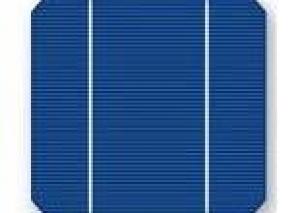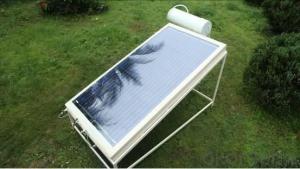Well Design High Efficiency Monocrystalline Silicon Solar Cells
- Loading Port:
- Tianjin
- Payment Terms:
- TT or LC
- Min Order Qty:
- 1200 watt
- Supply Capability:
- 700 watt/month
OKorder Service Pledge
OKorder Financial Service
You Might Also Like
Mechanical data and design of High Efficiency Monocrystalline Silicon Solar Cells
Format 125mm × 125mm ± 0.5 mm
Thickness- 210 μm ± 40 μm
Front (-) 1.6mm bus bars (silver),blue anti-reflection coating (silicon nitride)
Back (+) 2.5mm wide soldering pads (silver) back surface field (aluminium)
Temperature Coefficient of Cells
Voc. Temp .coef.%/K -0.35%/K
Isc . Temp .coef.%/K +0.024%/K
Pm. Temp. coef.%/K -0.47%/K
Electrical Characteristic
Efficiency (%) Pmpp (W) Umpp (V) Impp (A) Uoc (V) Isc (A) FF (%)
18.35 2.841 0.532 5.342 0.631 5.67 79.41%
18.2 2.817 0.53 5.319 0.631 5.64 79.16%
18.05 2.794 0.527 5.301 0.63 5.63 78.77%
17.9 2.771 0.527 5.259 0.629 5.62 78.39%
17.75 2.748 0.526 5.224 0.629 5.61 77.88%
17.6 2.725 0.524 5.201 0.629 5.59 77.50%
17.45 2.702 0.52 5.196 0.629 5.586 76.90%
17.3 2.678 0.516 5.183 0.626 5.577 76.71%
17.15 2.655 0.513 5.175 0.623 5.565 76.58%
17 2.632 0.51 5.161 0.622 5.559 76.12%
16.75 2.593 0.508 5.103 0.615 5.477 76.98%
16.5 2.555 0.506 5.047 0.608 5.396 77.88%
Brief introduction of Photovoltaic Cells Solar Panels
Photovoltaic Cells Solar Panels convert the solar radiation through the photoelectric effect or photochemical effect directly or indirectly into electrical energy by absorbing sunlight; the main material for most solar panels is silicon, but the production cost is so great that it cannot be a large number of widely and commonly used. Compared with ordinary batteries and rechargeable batteries, solar cells belong to more energy saving green products.
Advantages of Photovoltaic Cells Solar Panels
1) Solar energy resources are inexhaustible; solar energy shine on the planet currently consumes is 6,000 times larger than humanity to. Spread on Earth and the solar widespread, there are only local illumination can use solar photovoltaic panels, unrestricted area, elevation and other factors.
2), Solar energy resources are available everywhere, the nearest power supply. Without long-distance walks, preventing long-distance power transmission lines formed off the loss, but also has a throttling transmission costs. This is also the use of solar photovoltaic panels supplied premise transmission inconvenient western planning.
3), Energy conversion process of Photovoltaic Cells Solar Panels generating electricity is brief, which is a direct transition from photons to electrons. There is no central process (thermal energy into mechanical energy, mechanical energy is converted to electromagnetic energy, etc.) and mechanical activity, there is no mechanical wear. Based on thermodynamic analysis, Photovoltaic Cells Solar Panels generation with high theoretical efficiency, up to 80%, technology has great potential to develop.
4), Photovoltaic Cells Solar Panels do not use the fuel itself, does not emit any greenhouse gases and other substances, including gas, polluting air and noise, the impact will not suffer an energy crisis or the formation of the fuel market, is the real green environmental protection, new renewable energy sources.
5), Photovoltaic Cells Solar Panels generate electricity without cooling water process, the device may be in the desolate desert without water. PV can also be conveniently associated with the construction material, the composition of the construction of photovoltaic power generation system integration, covering not demand alone can choke precious resource site.
6), Photovoltaic Cells Solar Panels generate electricity without mechanical transmission components, operation, and maintenance simple, reliable operation of the same. A PV system only has a solar cell module can generate electricity, coupled with automatic control technology widely used; it can be done simply on unattended, low maintenance costs.
7), Photovoltaic Cells Solar Panels generate electricity tasking reliable, the service life (over 30 years). Crystalline silicon solar battery life is up to 20 to 35 years. In the photovoltaic power generation system, the only rational design, modeling appropriate battery life can last up to 10 to 15 years.
8), Photovoltaic Cells Solar Panels have simple structure, small size, light weight, easy to transport and installations. PV systems establish a short cycle, electricity load capacity vary, convenient and sensitive, easily combined expansion.
- Q:Can solar cells be used for water heating?
- Yes, solar cells can be used for water heating. Solar water heating systems use solar panels, which contain solar cells, to capture energy from the sun and convert it into heat. This heat is then used to warm water for various applications, such as domestic hot water or space heating.
- Q:Anybody ever heard of solar roll flexible solar panel?
- The flexible solar cell rolls is more convenient than the other solar cells because it can be stored in a convenient storage tube.
- Q:How do solar cells perform in dusty environments?
- Solar cells perform less efficiently in dusty environments due to reduced sunlight reaching the surface of the cells. Dust particles can accumulate on the surface of the solar panels, blocking the sunlight and reducing the amount of energy that can be converted. Regular cleaning and maintenance are necessary to ensure optimal performance in dusty conditions.
- Q:Can solar cells be used in cold climates?
- Yes, solar cells can be used in cold climates. Although solar cells are more efficient in warmer temperatures, they can still generate electricity even in cold climates. Additionally, advancements in solar technology have made it possible for solar cells to work efficiently in low-light and snowy conditions.
- Q:Can solar cells be used in disaster relief efforts?
- Yes, solar cells can be used in disaster relief efforts. Solar cells can provide a reliable source of clean and renewable energy, which is crucial during times of disaster when traditional power sources may be disrupted. Solar cells can power essential equipment and devices such as lighting, communication systems, medical equipment, and water purification systems, enabling relief workers to effectively respond to the needs of affected communities. Additionally, solar cells can be easily deployed and are not dependent on fuel supply or infrastructure, making them ideal for disaster-prone areas or remote locations.
- Q:Can solar cells be used in camping or outdoor recreational activities?
- Yes, solar cells can be used in camping or outdoor recreational activities. They are portable and can be used to power various devices such as smartphones, lights, and even small appliances. Solar panels can be easily set up in camping sites to harness energy from the sun and provide a sustainable and convenient power source in remote locations.
- Q:How much electricity can a solar cell generate?
- The amount of electricity that a solar cell can generate depends on various factors such as the size of the cell, the efficiency of the cell, the intensity of sunlight, and the duration of exposure. Generally, a solar cell can produce anywhere from a few watts to several hundred watts of electricity.
- Q:Can solar cells be used to power remote weather stations?
- Yes, solar cells can be used to power remote weather stations. Solar cells convert sunlight into electricity, providing a reliable and sustainable power source for remote locations. This eliminates the need for traditional power grid connections and reduces operating costs. Additionally, solar cells can be easily installed and maintained in remote areas, making them an ideal solution for powering weather stations in such locations.
- Q:I am working on research for the usage of solar cells, where can I find more news of solar cells?
- www.solardaily could be the website that you are looking for.
- Q:Can solar cells be used in public transportation?
- Yes, solar cells can be used in public transportation. They can be integrated into vehicles such as buses, trams, or trains to harness solar energy and power various onboard systems. Solar panels on the roof can generate electricity to charge batteries, power lighting and ventilation systems, or even propel the vehicle itself. This helps reduce reliance on traditional fuel sources and decreases carbon emissions, making public transportation more sustainable and environmentally friendly.
1. Manufacturer Overview |
|
|---|---|
| Location | Zhejiang, China |
| Year Established | 2008 |
| Annual Output Value | Above US$ 320 Million |
| Main Markets | Australia; Asia; South East Asia; South America; North America; Europe; Africa |
| Company Certifications | ISO 9001:2008; CE; TUV; UL |
2. Manufacturer Certificates |
|
|---|---|
| a) Certification Name | |
| Range | |
| Reference | |
| Validity Period | |
3. Manufacturer Capability |
|
|---|---|
| a)Trade Capacity | |
| Nearest Port | Ningbo, China |
| Export Percentage | 45% - 50% |
| No.of Employees in Trade Department | 200-300 People |
| Language Spoken: | English; Chinese |
| b)Factory Information | |
| Factory Size: | Above 10,000 Square meter |
| No. of Production Lines | 8 |
| Contract Manufacturing | OEM Service Offered; Design Service Offered |
| Product Price Range | Average |
Send your message to us
Well Design High Efficiency Monocrystalline Silicon Solar Cells
- Loading Port:
- Tianjin
- Payment Terms:
- TT or LC
- Min Order Qty:
- 1200 watt
- Supply Capability:
- 700 watt/month
OKorder Service Pledge
OKorder Financial Service
Similar products
New products
Hot products
Hot Searches
Related keywords






























